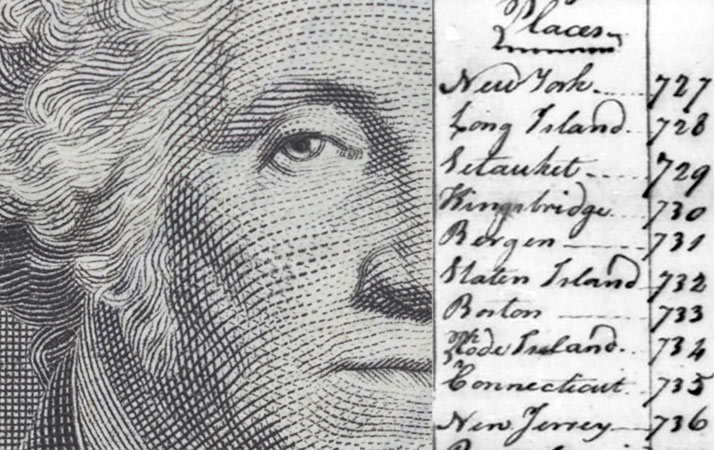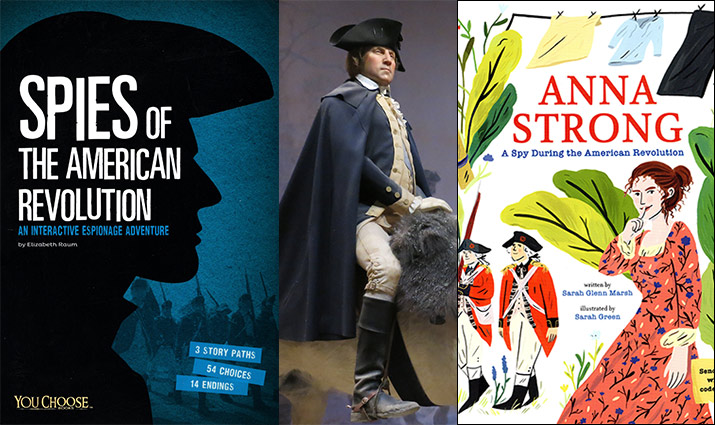1778, General George Washington, commander-in-chief of the Continental Army, was troubled.
The British army was a professional fighting force, battles had been lost, Washington’s soldiers were poorly equipped, underpaid volunteers.
To turn the war around, Washington had to find out about British movements and supplies.
Where was the British army, how many troops, weapons, and ships did they have, what were their plans to invade cities and forts?
George Washington needed spies.
Two years ago, a military volunteer, Nathan Hale, offered to go on a mission in New York, controlled by the British. Captured and revealed as a spy, Nathan Hale was hanged.
Washington set up a network of spies with everyday men and women.
One of the most famous, the Culper Ring, led by Benjamin Tallmadge, gathered vital information, tricked the British with fake documents, stole secret messages, and cracked codes.
Benjamin Tallmadge invented a code for his spies to transmit information. Words and people’s names were numbers, e.g. “George Washington” was 711, “British” – 72, “New York” – 727, “enemy” – 175. Spies were given new names and messages were often written in invisible ink.
Spies used other techniques too – tiny messages sewn inside shirt buttons, balls of yarn hiding information, laundry hanging on a line to signal meeting places, messages inside silver balls to be swallowed if the spy was caught.
At times spies pretended to be traitors, such as a slave who served under Lafayette, Joseph Armistad, who worked as a double agent, providing the British with false information. But traitors were also quite real – the most notorious one, Benedict Arnold.
Recruited by Major John Andre, Benedict Arnold provided military information and agreed to surrender West Point, a key fort, to the British. Andre was captured with plans for West Point and hanged as a spy, but Arnold escaped.
In the final battle at Yorktown, spies spread false information, intercepted communications and broke codes of the British general, an important contribution to victory by the Americans.
Even after the war ended, spies’ names were kept secret, as Washington promised. Years later, historians have found letters and family papers that reveal identities of these courageous people who risked their lives.
Kids will have fun reading about spy networks that helped win the American Revolution.
Children’s books
- Spies of the American Revolution: An Interactive Espionage Adventure by Elizabeth Raum
- Choose three different paths as a spy in the American Revolution – work for George Washington’s Culper Ring, spy for the British, or work as a double agent.
- Recruited in New York to work for the Culper Ring,learn code books and invisible ink, pass on important information, but it’s very dangerous. At any moment, British soldiers can discover the letters. Should you go into hiding, end up on a British prison ship, or keep spying until the end of the war? (Chapter book)
- Anna Strong: A Spy During the American Revolution by Sarah Glenn Marsh, Sarah Green
- Anna Strong lived on Long Island, which was controlled and occupied by the British. Like other members of the Culper Ring from Setauket, she helped gather information about the British, and pass important messages from other spies.
- When secret messages were ready to send on to George Washington, she would hang a black petticoat on her clothesline, and handkerchiefs would identify where a boat was hidden.
- At the end of the book, use the Culper Code to write your own messages in invisible ink. (Picture book)
- One Dead Spy by Nathan Hale
- “I regret I have but one life to give for my country.”
- Nathan Hale was an officer and a spy in the American Revolution. But what happened before September 22, 1776, when Hale tells his story to the hangman.
- Hale was a schoolteacher when the war began, joined the army, captured a British supply ship, then joined Knowlton’s Rangers as an intelligence officer. After the British took New York, Washington sent Hale undercover to find out about British troop movements. Alas, as soon as Hale landed on Long Island, he was spotted by an expert British spy, Major Rogers, and the rest is history. (Graphic novel)
- Tip: The author, Nathan Hale, lives in Utah with his family and children.
- George Washington, Spymaster by Thomas B. Allen
- Comprehensive overview of Washington’s network of spies throughout the American Revolution. The spies were ordinary men and women, who pretended to be Tories, gathered vital information, rooted out traitors, tricked the British with fake documents, stole secret messages, cracked codes, and helped win the war. At the end of the book is a complete list of the Culper Ring codes. Good for older kids. (Chapter book)
- Revolutionary Rogues: John Andre and Benedict Arnold by Selene Castrovilla, John O’Brien
- Major John Andre was educated, well mannered, a poet and artist; he was also a British spymaster.
- Originally a general and hero of the American Revolution, Benedict Arnold changed sides and offered his services to the British in 1779.
- John Andre welcomed Arnold, and provided a code book and invisible ink for communication. As commander of West Point, Arnold agreed to surrender the fort to the British, and passed plans of West Point to Andre. Discovered with Arnold’s information, Andre was captured as a spy, Arnold escaped, but continued to fight for the British. (Picture book)
- Phoebe the Spy by Judith Berry Griffin, Margot Tomes
- It’s 1776, the war has begun, General George Washington is staying in New York City. Queen’s Head tavern owned by Samuel Fraunces is a safe meeting place for the Patriots. Fraunces sends his daughter Phoebe to work in the house where Washington is staying, but her real task is to find out who’s plotting to kill the General. (Illustrated chapter book)
- Founding Fathers Were Spies by Patricia Lakin, Valerio Fabbretti
- Kids can read for themselves how George Washington created a spy network, how Ben Franklin and Alexander Hamilton hid messages in quill pens, Anna Strong signaled with laundry on the clothesline, how spies used secret messages, codes and invisible ink, plus activities for kids to make their own invisible ink and secret codes. (Easy reader)


